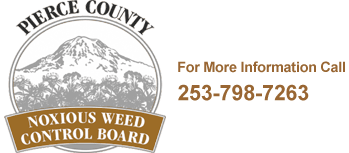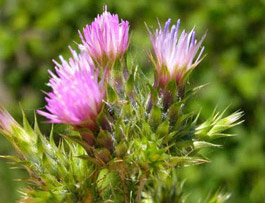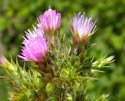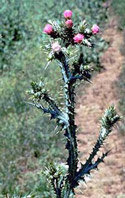Slenderflower Thistle
Carduus tenuiflorus • Class A |
||
| Family Name: | Asteraceae family (ass-ter-AY-see-ee) | |
| Common: | Aster, daisy, or sunflower family | |
| Genus: |
Carduus (KARD-yoo-us) Meaning: From the Greek word kardos (thistle) |
|
| Species: |
tenuiflorus (ten-yoo-ee-FLOR-uh) Meaning: Slender flowered |
|
| Description: |
Slenderflower thistles grow about 6 feet tall with prickly winged stems. It germinates in the fall, overwinters as a rosette, and produces flowering stalks in late spring. Leaves at the stem base are thorny, deeply cut into 2 to 5 pairs of spine tipped lobes, with tapered leaf bases that form into winged leaf stalks. Stem leaves are shorter, less lobed, and stalkless. Leaves are often covered with wooly looking hairs and light-colored veins. It can have many stems branching from the lower part of the plant with clusters of 5 to 20 flowers each under 1/2 inch in diameter. Flowers can range in color from pink to purple with usually more than five heads per cluster. Bracts are hairy and outer bracts are spine tipped. |
| Why Is it a Noxious Weed? |
Slenderflower thistle is extremely competitive and outcompetes native plant species and desirable vegetation. They form dense stands, which severely limit grazing of cattle or foraging of wildlife.This species is also a nitrate accumulator; ingestion by grazing animals may cause nitrate poisoning, which can be fatal to cattle or sheep. |
| Where Does it Grow? |
They infest roadsides, natural clearings, clear-cuts, industrial sites, and waste areas. They like dry, open areas such as pastures, ranges, and right-of-ways and are generally found in disturbed areas, and vacant lots. |
| Facts: |
Germination of seeds is rapid and occurs at high rates. Seed dispersal is by wind, water, and birds. Seeds remain viable in the soil for as long as 7 years. It produces 2 kinds of seeds, each about 3/4 of an inch long. Seeds produced by the central flowers in the head are cream colored, grooved and sticky with a plume of dirty white barbed hairs. This pappus is easily dispersed. The outer ring of flowers in the head produces seeds that are smooth, darker, non sticky and lack a pappus, have no obvious means of dispersal and are often dormant. |
| Control Options: |
|
| More Information: |
Download our Flyer or visit Washington State Noxious Weed Control Board Here. Photo by Leo Michels
|
| More Pictures: |







 Pierce County Noxious Weed Control Board • 9200 122nd St E, Puyallup, WA 98373 • 253-798-7263
Pierce County Noxious Weed Control Board • 9200 122nd St E, Puyallup, WA 98373 • 253-798-7263